Leroux-O'Connor Family site
Person Page 929

Leroux

O'Connor

Louis IX, Roi de France
M, #23201, b. 25 April 1214, d. 25 August 1270
Biography
- Louis IX, Roi de France, was born on 25 April 1214 in Poissy, Yvelines, Île-de-France, France.
- He and Marguerite, de Provence, Queen of France, were married on 27 May 1234 in Sens, Yonne, Bourgogne, France.
- He died on 25 August 1270 at age 56 in Tunis, Tunisia.
- He was buried in St-Denis, Seine-St-Denis, Île-de-France, France.
- Louis IX, Roi de France, was also known as Saint Louis, Ix.
- Louis IX (25 April 1214 – 25 August 1270), commonly known as Saint Louis or Louis the Saint, was King of France from 1226 to 1270, and the most illustrious of the Direct Capetians. He was crowned in Reims at the age of 12, following the death of his father Louis VIII. His mother, Blanche of Castile, ruled the kingdom as regent until he reached maturity, and then remained his valued adviser until her death. During Louis' childhood, Blanche dealt with the opposition of rebellious vassals and secured Capetian success in the Albigensian Crusade, which had started 20 years earlier.
As an adult, Louis IX faced recurring conflicts with some of his realm's most powerful nobles, such as Hugh X of Lusignan and Peter of Dreux. Simultaneously, Henry III of England attempted to restore the Angevin continental possessions, but was promptly routed at the Battle of Taillebourg. Louis annexed several provinces, notably parts of Aquitaine, Maine and Provence.
Louis IX enjoyed immense prestige throughout Christendom and was one of the most notable European monarchs of the Middle Ages. His reign is remembered as a medieval golden age in which the Kingdom of France reached an economic as well as political peak. His fellow European rulers esteemed him highly for his skill at arms, the power and unmatched wealth of his kingdom, but also for his reputation for fairness and moral integrity; he was often asked to arbitrate their disputes.
He was a reformer and developed a process of French royal justice in which the king was the supreme judge to whom anyone could in theory appeal for the amendment of a judgment. He banned trials by ordeal, tried to end the scourge of private wars, and introduced the presumption of innocence to criminal procedures. To enforce his new legal system, Louis IX created provosts and bailiffs.
Honoring a vow he had made while praying for recovery during a serious illness, Louis IX led the ill-fated Seventh Crusade and Eighth Crusade against the Muslim dynasties that ruled North Africa, Egypt and the Holy Land in the 13th century. He was captured in the first and ransomed, and he died from dysentery during the latter. He was succeeded by his son Philip III.
His admirers through the centuries have regarded Louis IX as the ideal Christian ruler. He was a splendid knight whose kindness and engaging manner made him popular, though contemporaries occasionally rebuked him as a "monk king". He was seen as inspired by Christian zeal and Catholic devotion. Enforcing strict Catholic orthodoxy, his laws punished blasphemy by mutilation of the tongue and lips, and he ordered the burning of some 12,000 manuscript copies of the Talmud and other important Jewish books after the Disputation of Paris of 1240. He is the only canonized king of France, and there are consequently many places named after him. - He was christened on 25 April 1214 at Collégiale Notre-Dame de Poissy in Poissy, Yvelines, Île-de-France, France.
- He held the title of King of France from 8 November 1226 to 25 August 1270.
- He was crowned on 29 November 1226 in Reims, Marne, Champagne-Ardenne, France.
- He is/was my 5th cousin 22x removed

Contemporary depiction of Louis IX from about 1230
Family: Marguerite, de Provence, Queen of France, (b. 1221, d. 21 December 1295)
- Philippe, III, Roi de France+ (b. 30 April 1245, d. 5 October 1285)
Parents
- Father: Louis VIII, Roi de France (b. 5 September 1187, d. 8 November 1226)
- Mother: Blanche de Castille, reine de France (b. 23 May 1188, d. 27 November 1252)
- Last Edited: 13 March 2022
Marguerite, de Provence, Queen of France
F, #23202, b. 1221, d. 21 December 1295
Biography
- Marguerite, de Provence, Queen of France, was born in 1221 in Provence, France.
- Louis IX, Roi de France, and she were married on 27 May 1234 in Sens, Yonne, Bourgogne, France.
- She died on 21 December 1295 at age ~74 in Paris, Ile-de-France, France.
- She was buried in December 1295 in St-Denis, Seine-St-Denis, Île-de-France, France.
- Marguerite, de Provence, Queen of France, is/was my spouse of 5th cousin 22x removed
Family: Louis IX, Roi de France, (b. 25 April 1214, d. 25 August 1270)
- Philippe, III, Roi de France+ (b. 30 April 1245, d. 5 October 1285)
- Last Edited: 18 March 2022
Philippe, III, Roi de France
M, #23203, b. 30 April 1245, d. 5 October 1285
Biography
- Philippe, III, Roi de France, was born on 30 April 1245 in Poissy, Yvelines, Île-de-France, France.
- He died on 5 October 1285 at age 40 in Perpignan, Pyrénées-Orientales, Languedoc-Roussillon, France.
- He was buried on 3 December 1285 at Couvent des Jacobins de la rue Saint-Jacques in Paris, Ile-de-France, France.
- Philippe, III, Roi de France, was also known as Philip, III of France.
- He was also known as Philip, The Bold.
- Philip III (1 May 1245 – 5 October 1285), called the Bold (French: le Hardi), was king of France from 1270 until his death in 1285. His father, Louis IX, died in Tunis during the Eighth Crusade. Philip, who was accompanying him, returned to France and was anointed king at Reims in 1271.
Philip inherited numerous territorial lands during his reign, the most notable being the County of Toulouse, which was returned to the royal domain in 1271. With the Treaty of Orléans, he expanded French influence into the Kingdom of Navarre and following the death of his brother Peter during the Sicilian Vespers, the County of Alençon was returned to the crown lands.
Following the Sicilian Vespers, Philip led the Aragonese Crusade in support of his uncle. Initially successful, Philip, his army racked with sickness, was forced to retreat and died from dysentery in Perpignan in 1285. He was succeeded by his son Philip IV. - He was christened on 1 May 1245 in Poissy, Yvelines, Île-de-France, France.
- He held the title of King of France from 25 August 1270 to 5 October 1285.
- He was crowned on 30 August 1271 in Reims, Marne, Champagne-Ardenne, France.
- He is/was my 6th cousin 21x removed
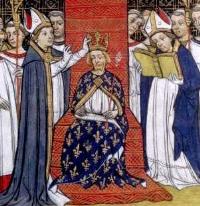
Coronation of King Philip III
Family: Isabelle d'Aragon, Reine de France, (b. 8 May 1248, d. 28 January 1271)
- Louis, de France (b. 1265, d. May 1276)
- Philippe, IV King of France+ (b. 28 May 1268, d. 29 November 1314)
- Prince Robert de France (b. 1269, d. 1276)
- Charles de Valois, Comte de Valois+ (b. 12 March 1270, d. 16 December 1325)
Parents
- Father: Louis IX, Roi de France (b. 25 April 1214, d. 25 August 1270)
- Mother: Marguerite, de Provence, Queen of France (b. 1221, d. 21 December 1295)
- Last Edited: 17 March 2022
Isabelle d'Aragon, Reine de France
F, #23204, b. 8 May 1248, d. 28 January 1271
Biography
- Isabelle d'Aragon, Reine de France, was born on 8 May 1248 in Barcelona, Catalonia, Spain.
- She died on 28 January 1271 at age 22 in Hières-sur-Amby, Rhône-Alpes, France.
- She was buried in 1271 in France.
- Isabelle d'Aragon, Reine de France, is/was my spouse of 6th cousin 21x removed
Family: Philippe, III, Roi de France, (b. 30 April 1245, d. 5 October 1285)
- Louis, de France (b. 1265, d. May 1276)
- Philippe, IV King of France+ (b. 28 May 1268, d. 29 November 1314)
- Prince Robert de France (b. 1269, d. 1276)
- Charles de Valois, Comte de Valois+ (b. 12 March 1270, d. 16 December 1325)
- Last Edited: 13 March 2022
Louis, de France
M, #23205, b. 1265, d. May 1276
Biography
- Louis, de France, was born in 1265 in Lot-et-Garonne, Aquitaine, France.
- He died in May 1276 at age ~11 in Fontainebleau, Seine-et-Marne, France.
- He was buried in St-Denis, Seine-St-Denis, Île-de-France, France.
- Louis, de France, is/was my 7th cousin 20x removed
Parents
- Father: Philippe, III, Roi de France (b. 30 April 1245, d. 5 October 1285)
- Mother: Isabelle d'Aragon, Reine de France (b. 8 May 1248, d. 28 January 1271)
- Last Edited: 13 March 2022
Louis, X, King of France et de Navarre
M, #23206, b. 4 October 1289, d. 5 June 1316
Biography
- Louis, X, King of France et de Navarre, was born on 4 October 1289 in Paris, Ile-de-France, France.
- He and Marguerite de Bourgogne were married on 23 September 1305 in Corbeil-Essonne, Essonne, Île-de-France, France.
- He and Clémence de Hongrie were married on 19 August 1315 in Paris, Ile-de-France, France.
- He died on 5 June 1316 at age 26 in Vincennes, Val-de-Marne, Île-de-France, France.
- He was buried in Seine-Saint-Denis, Saint-Denis, France.
- Louis X (4 October 1289 – 5 June 1316), called the Quarrelsome, the Headstrong, or the Stubborn (French: le Hutin), was King of France from 1314 and King of Navarre as Louis I (Basque: Luis) from 1305 until his death. He abolished slavery, emancipated serfs who could buy their freedom, and readmitted Jews into the kingdom.
His short reign in France was marked by tensions with the nobility, due to fiscal and centralisation reforms initiated by Grand Chamberlain Enguerrand de Marigny under the reign of his father. Louis' uncle—Charles of Valois, leader of the feudalist party—managed to convince the king to execute Enguerrand de Marigny. - Louis, X, King of France et de Navarre, held the title of King of Navarre from 4 April 1305 to 5 June 1316.
- He held the title of King of France from 29 November 1314 to 5 June 1316.
- He is/was my 8th cousin 19x removed
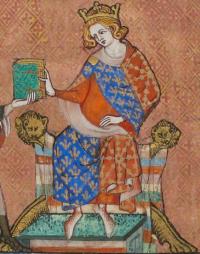
Miniature depiction from the Vie de saint Louis, c. 1330–1340
Family 1: Marguerite de Bourgogne (b. 1292, d. 14 August 1315)
- Jeanne II de France, Queen of Navarre (b. 28 January 1312, d. 6 October 1349)
Family 2: Clémence de Hongrie (b. 8 February 1293, d. 12 October 1328)
- Jean, I, King of France (b. 15 November 1316, d. 20 November 1316)
Parents
- Father: Philippe, IV King of France (b. 28 May 1268, d. 29 November 1314)
- Mother: Jeanne de Navarre de Champagne (b. 14 January 1273, d. 2 April 1305)
- Last Edited: 17 March 2022
Philippe, V King of France
M, #23207, b. 17 November 1293, d. 3 January 1322
Biography
- Philippe, V King of France, was born on 17 November 1293 in Lyon, Rhône, Rhone-Alpes, France.
- He died on 3 January 1322 at age 28 in Paris, Ile-de-France, France.
- He was buried after 3 January 1322 at Basilique Saint Denis in St-Denis, Seine-St-Denis, Île-de-France, France.
- Philip V (c. 1293 – 3 January 1322), known as the Tall (French: Philippe le Long), was the King of France and Navarre (as Philip II) from 1316 to 1322.
As the second son of king Philip IV, he was granted an appanage, the County of Poitiers, while his elder brother, Louis X, inherited the throne in 1314. When Louis died in 1316, he left a daughter and a pregnant wife, Clementia of Hungary. Philip the Tall successfully claimed the regency. Queen Clementia gave birth to a boy, who was proclaimed king as John I, but the infant king lived only for five days.
At the death of his nephew, Philip immediately had himself crowned at Reims. However, his legitimacy was challenged by the party of Louis X's daughter Joan. Philip V successfully contested her claims for a number of reasons, including her youth, doubts regarding her paternity (her mother was involved in the Tour de Nesle Affair), and the Estates General's determination that women should be excluded from the line of succession to the French throne. The succession of Philip, instead of Joan, set the precedent for the French royal succession that would be known as the Salic law.
Philip V restored somewhat good relations with the County of Flanders, which had entered into open rebellion during his father's rule, but simultaneously his relations with Edward II of England worsened as the English king, who was also Duke of Guyenne, initially refused to pay him homage. A spontaneous popular crusade started in Normandy in 1320 aiming to liberate the Iberian Peninsula from the Moors. Instead the angry populace marched to the south attacking castles, royal officials, priests, lepers, and Jews.
Philip V engaged in a series of domestic reforms intended to improve the management of the kingdom. These reforms included the creation of an independent Court of Finances, the standardization of weights and measures, and the establishment of a single currency.
Philip V died from dysentery in 1322 without a male heir and was succeeded by his younger brother Charles IV. - Philippe, V King of France, held the title of King of France and Navarre from 20 November 1316 to 3 January 1322.
- He is/was my 8th cousin 19x removed
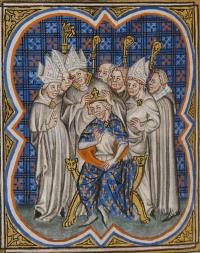
Contemporary miniature depicting the coronation of Philip V
Parents
- Father: Philippe, IV King of France (b. 28 May 1268, d. 29 November 1314)
- Mother: Jeanne de Navarre de Champagne (b. 14 January 1273, d. 2 April 1305)
- Last Edited: 17 March 2022
Charles, IV King of France
M, #23208, b. 18 June 1294, d. 1 February 1328
Biography
- Charles, IV King of France, was born on 18 June 1294 in Clermont, Departement de l'Oise, Picardie, France.
- He died on 1 February 1328 at age 33 in Vincennes, Val-de-Marne, Île-de-France, France.
- He was buried on 7 February 1328 at Basilique Saint Denis in St-Denis, Seine-St-Denis, Île-de-France, France.
- Charles IV (18/19 June 1294 – 1 February 1328), called the Fair (le Bel) in France and the Bald (el Calvo) in Navarre, was last king of the direct line of the House of Capet, King of France and King of Navarre (as Charles I) from 1322 to 1328. Charles was the third son of Philip IV; like his father, he was known as "the fair" or "the handsome".[2][3]
Beginning in 1323 Charles was confronted with a peasant revolt in Flanders, and in 1324 he made an unsuccessful bid to be elected Holy Roman Emperor. As Duke of Guyenne, King Edward II of England was a vassal of Charles, but he was reluctant to pay homage to another king. In retaliation, Charles conquered the Duchy of Guyenne in a conflict known as the War of Saint-Sardos (1324). In a peace agreement, Edward II accepted to swear allegiance to Charles and to pay a fine. In exchange, Guyenne was returned to Edward but with a much-reduced territory.
When Charles IV died without a male heir, the senior line of the House of Capet, descended from Philip IV, became extinct. He was succeeded in Navarre by his niece Joan II and in France by his paternal first cousin Philip of Valois. However, the dispute on the succession to the French throne between the Valois monarchs descended in male line from Charles's grandfather Philip III of France, and the English monarchs descended from Charles's sister Isabella, was a factor of the Hundred Years' War. - Charles, IV King of France, held the title of King of France from 3 January 1322 to 1 February 1328.
- He held the title of King of Navarre from 3 January 1322 to 1 February 1328.
- He is/was my 8th cousin 19x removed
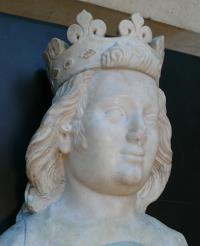
Gisant of Charles IV by Jean de Liège, c. 1372
Parents
- Father: Philippe, IV King of France (b. 28 May 1268, d. 29 November 1314)
- Mother: Jeanne de Navarre de Champagne (b. 14 January 1273, d. 2 April 1305)
- Last Edited: 13 March 2022
Blanche
F, #23209, b. 1290, d. 1294
Biography
- Blanche was born in 1290.
- She died in 1294 at age ~4.
- Blanche is/was my 8th cousin 19x removed
Parents
- Father: Philippe, IV King of France (b. 28 May 1268, d. 29 November 1314)
- Mother: Jeanne de Navarre de Champagne (b. 14 January 1273, d. 2 April 1305)
- Last Edited: 13 March 2022
Marguerite Of France
F, #23210, b. 1288, d. 1294
Biography
- Marguerite Of France was born in 1288.
- She died in 1294 at age ~6.
- Marguerite Of France is/was my 8th cousin 19x removed
Parents
- Father: Philippe, IV King of France (b. 28 May 1268, d. 29 November 1314)
- Mother: Jeanne de Navarre de Champagne (b. 14 January 1273, d. 2 April 1305)
- Last Edited: 13 March 2022
Marguerite de Bourgogne
F, #23211, b. 1292, d. 14 August 1315
Biography
- Marguerite de Bourgogne was born in 1292.
- Louis, X, King of France et de Navarre, and she were married on 23 September 1305 in Corbeil-Essonne, Essonne, Île-de-France, France.
- She died on 14 August 1315 at age ~23 at dans la Forteresse de Château-Gaillard in Les Andelys, Haute-Normandie, France.
- She was buried at chapelle Hôtel-Dieu in Tonnerre, Yonne, Bourgogne, France.
- Marguerite de Bourgogne is/was my spouse of 8th cousin 19x removed
Family: Louis, X, King of France et de Navarre, (b. 4 October 1289, d. 5 June 1316)
- Jeanne II de France, Queen of Navarre (b. 28 January 1312, d. 6 October 1349)
- Last Edited: 13 March 2022
Jeanne II de France, Queen of Navarre
F, #23212, b. 28 January 1312, d. 6 October 1349
Biography
- Jeanne II de France, Queen of Navarre, was born on 28 January 1312 at Conflans-Sainte-Honorine, Yvelines, in Paris, Ile-de-France, France.
- She died on 6 October 1349 at age 37 at Conflans-Sainte-Honorine, Yvelines, in Paris, Ile-de-France, France.
- She was buried after 6 October 1349 in Seine-Saint-Denis, Saint-Denis, France.
- Jeanne II de France, Queen of Navarre, is/was my 9th cousin 18x removed
Parents
- Father: Louis, X, King of France et de Navarre (b. 4 October 1289, d. 5 June 1316)
- Mother: Marguerite de Bourgogne (b. 1292, d. 14 August 1315)
- Last Edited: 18 March 2022
Clémence de Hongrie
F, #23213, b. 8 February 1293, d. 12 October 1328
Biography
- Clémence de Hongrie was born on 8 February 1293 in Naples, Campania, Italy.
- Louis, X, King of France et de Navarre, and she were married on 19 August 1315 in Paris, Ile-de-France, France.
- She died on 12 October 1328 at age 35 in Paris, Ile-de-France, France.
- She was buried at Couvent des Jacobins de la rue Saint-Jacques in Paris, Ile-de-France, France.
- Clémence de Hongrie is/was my spouse of 8th cousin 19x removed
Family: Louis, X, King of France et de Navarre, (b. 4 October 1289, d. 5 June 1316)
- Jean, I, King of France (b. 15 November 1316, d. 20 November 1316)
- Last Edited: 13 March 2022
Jean, I, King of France
M, #23214, b. 15 November 1316, d. 20 November 1316
Biography
- Jean, I, King of France, was born on 15 November 1316 at Louvre Palace in Paris, Ile-de-France, France.
- He died on 20 November 1316 at age 0 in Paris, Ile-de-France, France.
- He was buried after 20 November 1316 at basilique in St-Denis, Seine-St-Denis, Île-de-France, France.
- Jean, I, King of France, was also known as John, I of France.
- He was also known as John, I the Posthumous.
- Ohn I (15–20 November 1316), called the Posthumous (French: Jean Ier le Posthume, Occitan: Joan Ièr lo Postume), was king of France and Navarre, as the posthumous son and successor of Louis X, for the five days he lived in 1316. He is the youngest person to be king of France, the only one to have borne that title from birth, and the only one to hold the title for his entire life. His reign is the shortest of any French king.[note 1] Although considered a king today, his status was not recognized until chroniclers and historians in later centuries began numbering John II, thereby acknowledging John I's brief reign.[1]
John reigned for five days under the regency of his uncle, Philip V of France, until his death on 20 November 1316. His death ended the three centuries of father-to-son succession to the French throne. The infant king was buried in the Basilica of Saint-Denis. He was succeeded by his uncle, Philip, whose contested legitimacy led to the re-affirmation of the Salic law, which excluded women from the line of succession to the French throne. - He held the title of King of France from 15 November 1316 to 20 November 1316.
- He is/was my 9th cousin 18x removed
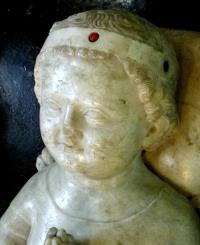
Tomb effigy of John the Posthumous
Parents
- Father: Louis, X, King of France et de Navarre (b. 4 October 1289, d. 5 June 1316)
- Mother: Clémence de Hongrie (b. 8 February 1293, d. 12 October 1328)
- Last Edited: 13 March 2022
Charles de Valois, Comte de Valois
M, #23215, b. 12 March 1270, d. 16 December 1325
Biography
- Charles de Valois, Comte de Valois, was born on 12 March 1270 in Vincennes, Val-de-Marne, Île-de-France, France.
- He and Marguerite d'Anjou, Comtesse d'Anjou et du Maine, were married in 1291.
- He died on 16 December 1325 at age 55 in Nogent-le-Roi, Eure-et-Loir, France.
- He was buried after 16 December 1325 at Saint Denis Basilica in St-Denis, Seine-St-Denis, Île-de-France, France.
- Charles de Valois, Comte de Valois, was christened after 12 March 1270 in Fontainebleau, Seine-et-Marne, France.
- He is/was my 7th cousin 20x removed
Family: Marguerite d'Anjou, Comtesse d'Anjou et du Maine, (b. about 1274, d. 31 December 1299)
- Philip, VI King of France+ (b. 17 November 1293, d. 22 August 1350)
Parents
- Father: Philippe, III, Roi de France (b. 30 April 1245, d. 5 October 1285)
- Mother: Isabelle d'Aragon, Reine de France (b. 8 May 1248, d. 28 January 1271)
- Last Edited: 13 March 2022
Prince Robert de France
M, #23217, b. 1269, d. 1276
Biography
- Prince Robert de France was born in 1269 in Fontainebleau, Seine-et-Marne, France.
- He died in 1276 at age ~7 in Cosenza, Calabria, Italy.
- He was buried in 1276 in St-Denis, Seine-St-Denis, Île-de-France, France.
- Prince Robert de France is/was my 7th cousin 20x removed
Parents
- Father: Philippe, III, Roi de France (b. 30 April 1245, d. 5 October 1285)
- Mother: Isabelle d'Aragon, Reine de France (b. 8 May 1248, d. 28 January 1271)
- Last Edited: 13 March 2022
Philip, VI King of France
M, #23218, b. 17 November 1293, d. 22 August 1350
Biography
- Philip, VI King of France, was born on 17 November 1293 at Fontainebleau in Paris, Ile-de-France, France.
- He and Joan, the Lame, were married in July 1313.
- He died on 22 August 1350 at age 56 at Coulombes Abbey in Nogent-le-Roi, Eure-et-Loir, France.
- He was buried after 22 August 1350 at Saint Denis Basilica in St-Denis, Seine-St-Denis, Île-de-France, France.
- Philip VI (French: Philippe; 17 November 1293 – 22 August 1350), called the Fortunate (French: le Fortuné) and of Valois, was the first King of France from the House of Valois, reigning from 1328 until his death in 1350.
Philip's reign was dominated by the consequences of a succession dispute. When King Charles IV of France died in 1328, the nearest male relative was his nephew King Edward III of England, but the French nobility preferred Charles's paternal cousin Philip. At first, Edward seemed to accept Philip's succession, but he pressed his claim to the throne of France after a series of disagreements with Philip. The result was the beginning of the Hundred Years' War in 1337.
After initial successes at sea, Philip's navy was annihilated at the Battle of Sluys in 1340, ensuring that the war would occur on the continent. The English took another decisive advantage at the Battle of Crécy (1346), while the Black Death struck France, further destabilizing the country.
In 1349, King Philip VI bought the Province of Dauphiné from its ruined ruler the Dauphin Humbert II of Viennois and entrusted the government of this province to his grandson King Charles V. Philip VI died in 1350 and was succeeded by his son King John II, the Good. - Philip, VI King of France, held the title of King of France from 1 April 1328 to 22 August 1350.
- He is/was my 8th cousin 19x removed
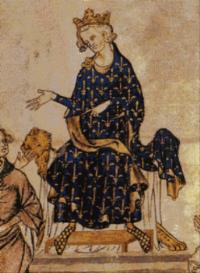
Philip VI in a contemporary miniature depicting the trial of Robert III of Artois, c. 1336
Family: Joan, the Lame, (b. about 1293, d. 12 December 1349)
- Jean, II King of France+ (b. 26 April 1319, d. 8 April 1364)
Parents
- Father: Charles de Valois, Comte de Valois (b. 12 March 1270, d. 16 December 1325)
- Mother: Marguerite d'Anjou, Comtesse d'Anjou et du Maine (b. about 1274, d. 31 December 1299)
- Last Edited: 13 March 2022
Marguerite d'Anjou, Comtesse d'Anjou et du Maine
F, #23219, b. about 1274, d. 31 December 1299
Biography
- Marguerite d'Anjou, Comtesse d'Anjou et du Maine, was born about 1274 in Sicily, Italy.
- Charles de Valois, Comte de Valois, and she were married in 1291.
- She died on 31 December 1299.
- She was buried at Couvent des Jacobins de la rue Saint-Jacques in Paris, Ile-de-France, France.
- Marguerite d'Anjou, Comtesse d'Anjou et du Maine, is/was my spouse of 7th cousin 20x removed
Family: Charles de Valois, Comte de Valois, (b. 12 March 1270, d. 16 December 1325)
- Philip, VI King of France+ (b. 17 November 1293, d. 22 August 1350)
- Last Edited: 18 March 2022
Joan, the Lame
F, #23220, b. about 1293, d. 12 December 1349
Biography
- Joan, the Lame, was born about 1293.
- Philip, VI King of France, and she were married in July 1313.
- She died on 12 December 1349.
- Joan, the Lame, was also known as Jeanne.
- She was also known as Joan, of Burgundy.
- She is/was my spouse of 8th cousin 19x removed
Family: Philip, VI King of France, (b. 17 November 1293, d. 22 August 1350)
- Jean, II King of France+ (b. 26 April 1319, d. 8 April 1364)
- Last Edited: 13 March 2022
Jean, II King of France
M, #23221, b. 26 April 1319, d. 8 April 1364
Biography
- Jean, II King of France, was born on 26 April 1319 in Le Mans, Pays de la Loire, France.
- He and Bonne de Luxembourg, Comtesse du Maine et d'Anjou, were married on 28 July 1332 in Melun, Île-de-France, France.
- He died on 8 April 1364 at age 44 at Savoy Palace in London, Middlesex, England.
- He was buried after 8 April 1365 at Basilique Saint Denis in St-Denis, Seine-St-Denis, Île-de-France, France.
- Jean, II King of France, was also known as John, the Good.
- He was also known as John, II King of France.
- John II (French: Jean II; 26 April 1319 – 8 April 1364), called John the Good (French: Jean le Bon), was King of France from 1350 until his death in 1364. When he came to power, France faced several disasters: the Black Death, which killed nearly 40% of its population; popular revolts known as Jacqueries; free companies (Grandes Compagnies) of routiers who plundered the country; and English aggression that resulted in catastrophic military losses, including the Battle of Poitiers of 1356, in which John was captured.
While John was a prisoner in London, his son Charles became regent and faced several rebellions, which he overcame. To liberate his father, he concluded the Treaty of Brétigny (1360), by which France lost many territories and paid an enormous ransom. In an exchange of hostages, which included his second son Louis, Duke of Anjou, John was released from captivity to raise funds for his ransom. Upon his return to France, he created the franc to stabilize the currency and tried to get rid of the free companies by sending them to a crusade, but Pope Innocent VI died shortly before their meeting in Avignon. When John was informed that Louis had escaped from captivity, he voluntarily returned to England, where he died in 1364. He was succeeded by his son Charles V. - He was christened on 29 April 1319 in Le Mans, Pays de la Loire, France.
- He held the title of King of France from 22 August 1350 to 8 April 1364.
- He is/was my 9th cousin 18x removed
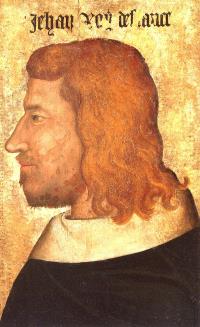
Portrait on wood panel around 1350, Louvre Museum
Family: Bonne de Luxembourg, Comtesse du Maine et d'Anjou, (b. 20 May 1315, d. 11 September 1349)
- Charles, V King of France+ (b. 21 January 1338, d. 16 September 1380)
- Marie de France, Duchesse de Bar+ (b. 18 September 1344, d. 2 October 1404)
Parents
- Father: Philip, VI King of France (b. 17 November 1293, d. 22 August 1350)
- Mother: Joan, the Lame (b. about 1293, d. 12 December 1349)
- Last Edited: 20 March 2022
Bonne de Luxembourg, Comtesse du Maine et d'Anjou
F, #23222, b. 20 May 1315, d. 11 September 1349
Biography
- Bonne de Luxembourg, Comtesse du Maine et d'Anjou, was born on 20 May 1315 in Praha, Praha, Hlavní Mesto, Czech Republic.
- Jean, II King of France, and she were married on 28 July 1332 in Melun, Île-de-France, France.
- She died on 11 September 1349 at age 34 in Val-d'Oise, Île-de-France, France.
- She was buried on 11 September 1349 at La Briche in St-Denis, Seine-St-Denis, Île-de-France, France.
- Bonne de Luxembourg, Comtesse du Maine et d'Anjou, is/was my spouse of 9th cousin 18x removed
Family: Jean, II King of France, (b. 26 April 1319, d. 8 April 1364)
- Charles, V King of France+ (b. 21 January 1338, d. 16 September 1380)
- Marie de France, Duchesse de Bar+ (b. 18 September 1344, d. 2 October 1404)
- Last Edited: 13 March 2022
Charles, V King of France
M, #23223, b. 21 January 1338, d. 16 September 1380
Biography
- Charles, V King of France, was born on 21 January 1338 in Vincennes, Val-de-Marne, Île-de-France, France.
- He died on 16 September 1380 at age 42 in Vincennes, Val-de-Marne, Île-de-France, France.
- He was buried after 16 September 1380 in St-Denis, Seine-St-Denis, Île-de-France, France.
- Charles V (21 January 1338 – 16 September 1380), called the Wise (French: le Sage; Latin: Sapiens), was King of France from 1364 to his death in 1380. His reign marked an early high point for France during the Hundred Years' War, with his armies recovering much of the territory held by the English, and successfully reversed the military losses of his predecessors.
Charles became regent of France when his father John II was captured by the English at the Battle of Poitiers in 1356. To pay for the defense of the kingdom, Charles raised taxes. As a result, he faced hostility from the nobility, led by Charles the Bad, King of Navarre; the opposition of the French bourgeoisie, which was channeled through the Estates-General led by Étienne Marcel; and with a peasant revolt known as the Jacquerie. Charles overcame all of these rebellions, but in order to liberate his father, he had to conclude the Treaty of Brétigny in 1360, in which he abandoned large portions of south-western France to Edward III of England and agreed to pay a huge ransom.
Charles became king in 1364. With the help of talented advisers, his skillful management of the kingdom allowed him to replenish the royal treasury and to restore the prestige of the House of Valois. He established the first permanent army paid with regular wages, which liberated the French populace from the companies of routiers who regularly plundered the country when not employed. Led by Bertrand du Guesclin, the French Army was able to turn the tide of the Hundred Years' War to Charles' advantage, and by the end of Charles' reign, they had reconquered almost all the territories ceded to the English in 1360. Furthermore, the French fleet, led by Jean de Vienne, managed to attack the English coast for the first time since the beginning of the Hundred Years' War.
Charles V died in 1380. He was succeeded by his son Charles VI, whose disastrous reign allowed the English to regain control of large parts of France. - Charles, V King of France, was crowned on 19 March 1364 in Reims, Marne, Champagne-Ardenne, France.
- He held the title of King of France from 8 April 1364 to 16 September 1380.
- He is/was my 10th cousin 17x removed
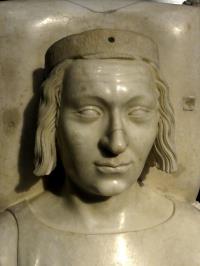
Contemporary effigy of Charles the Wise aged 27, by André Beauneveu, in the Basilica of Saint-Denis
Family: Jeanne de Bourbon, Reine de France, (b. 3 February 1338, d. 6 February 1377)
- Charles, VI King of France+ (b. 3 December 1368, d. 21 October 1422)
- Louis I d'Orléans, Duc d'Orléans+ (b. 13 March 1372, d. 23 November 1407)
Parents
- Father: Jean, II King of France (b. 26 April 1319, d. 8 April 1364)
- Mother: Bonne de Luxembourg, Comtesse du Maine et d'Anjou (b. 20 May 1315, d. 11 September 1349)
- Last Edited: 13 March 2022
Jeanne de Bourbon, Reine de France
F, #23224, b. 3 February 1338, d. 6 February 1377
Biography
- Jeanne de Bourbon, Reine de France, was born on 3 February 1338 in Vincennes, Val-de-Marne, Île-de-France, France.
- She died on 6 February 1377 at age 39 in Paris, Ile-de-France, France.
- She was buried in St-Denis, Seine-St-Denis, Île-de-France, France.
- Jeanne de Bourbon, Reine de France, is/was my spouse of 10th cousin 17x removed
Family: Charles, V King of France, (b. 21 January 1338, d. 16 September 1380)
- Charles, VI King of France+ (b. 3 December 1368, d. 21 October 1422)
- Louis I d'Orléans, Duc d'Orléans+ (b. 13 March 1372, d. 23 November 1407)
- Last Edited: 13 March 2022
Charles, VII King of France
M, #23225, b. 22 February 1403, d. 22 July 1461
Biography
- Charles, VII King of France, was born on 22 February 1403 in Paris, Ile-de-France, France.
- He and Marie d'Anjou, Reine de France, were married on 14 April 1423 in France.
- He died on 22 July 1461 at age 58 in Mehun-sur-Yèvre, Cher, Centre-Val de Loire, France.
- He was buried on 8 August 1461 at Saint Denis Basilica in St-Denis, Seine-St-Denis, Île-de-France, France.
- Charles VII (22 February 1403 – 22 July 1461), called the Victorious (French: le Victorieux) or the Well-Served (le Bien-Servi), was King of France from 1422 to his death in 1461.
In the midst of the Hundred Years' War, Charles VII inherited the throne of France under desperate circumstances. Forces of the Kingdom of England and the duke of Burgundy occupied Guyenne and northern France, including Paris, the most populous city, and Reims, the city in which French kings were traditionally crowned. In addition, his father, Charles VI, had disinherited him in 1420 and recognized Henry V of England and his heirs as the legitimate successors to the French crown. At the same time, a civil war raged in France between the Armagnacs (supporters of the House of Valois) and the Burgundian party (supporters of the House of Valois-Burgundy, which was allied to the English).
With his court removed to Bourges, south of the Loire River, Charles was disparagingly called the "King of Bourges", because the area around this city was one of the few remaining regions left to him. However, his political and military position improved dramatically with the emergence of Joan of Arc as a spiritual leader in France. Joan and other charismatic figures led French troops to lift the sieges of Orléans and other strategic cities on the Loire river, and to crush the English at the battle of Patay. With the local English troops dispersed, the people of Reims switched allegiance and opened their gates, which enabled the coronation of Charles VII at Reims Cathedral in 1429. Six years later, he ended the English-Burgundian alliance by signing the Treaty of Arras with Burgundy, followed by the recovery of Paris in 1436 and the steady reconquest of Normandy in the 1440s using a newly organized professional army and advanced siege cannons. Following the battle of Castillon in 1453, the French expelled the English from all their continental possessions except the Pale of Calais.
The last years of Charles VII were marked by conflicts with his turbulent son, the future Louis XI of France. - Charles, VII King of France, held the title of King of France from 21 October 1422 to 22 July 1461.
- He is/was my 12nd cousin 15x removed
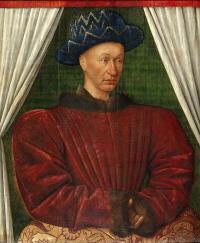
Portrait by Jean Fouquet, tempera on wood, Louvre Museum, Paris, c. 1445–1450
Family: Marie d'Anjou, Reine de France, (b. 14 October 1404, d. 29 November 1463)
- Louis, XI King of France+ (b. 3 July 1423, d. 30 August 1483)
- Madeleine, de France de Valois+ (b. 1 December 1443, d. 21 January 1495)
Parents
- Father: Charles, VI King of France (b. 3 December 1368, d. 21 October 1422)
- Mother: Elisabeth von Bayern, Reine de France (b. 27 October 1369, d. 24 September 1435)
- Last Edited: 13 March 2022